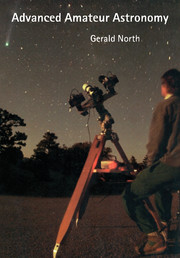Book contents
- Frontmatter
- Contents
- Preface to the second edition
- Preface to the first edition
- Acknowledgements
- 1 Telescope optics
- 2 Atmosphere, seeing, magnification and eyepieces
- 3 Telescope hardware and adjustments
- 4 Astrophotography with the camera
- 5 Astrophotography through the telescope
- 6 Electronic imaging
- 7 The Moon
- 8 The terrestrial planets
- 9 The gas-giant planets
- 10 Asteroids, comets, meteors and aurorae
- 11 The Sun
- 12 Variable stars and novae
- 13 Methods of photometry
- 14 Double stars, star clusters, nebulae, galaxies and supernovae
- 15 Spectroscopy
- 16 Radio astronomy
- 17 Further information
- Appendix: Useful formulae
- Index
8 - The terrestrial planets
Published online by Cambridge University Press: 04 August 2010
- Frontmatter
- Contents
- Preface to the second edition
- Preface to the first edition
- Acknowledgements
- 1 Telescope optics
- 2 Atmosphere, seeing, magnification and eyepieces
- 3 Telescope hardware and adjustments
- 4 Astrophotography with the camera
- 5 Astrophotography through the telescope
- 6 Electronic imaging
- 7 The Moon
- 8 The terrestrial planets
- 9 The gas-giant planets
- 10 Asteroids, comets, meteors and aurorae
- 11 The Sun
- 12 Variable stars and novae
- 13 Methods of photometry
- 14 Double stars, star clusters, nebulae, galaxies and supernovae
- 15 Spectroscopy
- 16 Radio astronomy
- 17 Further information
- Appendix: Useful formulae
- Index
Summary
Long-term observations of the Solar System bodies have traditionally been the province of the amateur. Space probe missions have come and gone and we have learned much as a result. The terrestrial planets have been mapped to a far higher resolution than is possible from the Earth. The planet Mercury is, frankly, not a very satifactory target for continued Earth-based observation. However, the same is certainly not true of Venus and Mars. These planets are much easier targets and diplay interesting changes and phenomena that can only be appreciated by long-term study. We may have learned much from the space probes but there is still plenty more we don't know!
Telescopes for planetary observation
The first three chapters of this book deal in detail with telescopic equipment. Sheer light grasp is not an essential for planetary observation. Much more important is that the image is as sharp and contrasty as possible. My advice to any planetary observer is to invest in quality optics, rather than the largest affordable aperture.
A large focal ratio is more conducive to high quality imaging (eyepieces, in particular, deliver better quality images when working with higher focal ratios) but is not an essential. Refractors can deliver very fine images provided their secondary spectra are not too prominent. However, if value for money is sought then I would recommend the Newtonian reflector every time. This old warhorse is capable of delivering very fine images, provided its optics are of first class quality and are in good collimation.
- Type
- Chapter
- Information
- Advanced Amateur Astronomy , pp. 180 - 200Publisher: Cambridge University PressPrint publication year: 1997



